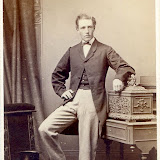An itinerant gold rush photographer.
“There are always two people in every picture: the photographer and the viewer.”
Ansel Adams
The career of Perez Mann Batchelder could be considered the essential story of the 19th century studio photographer; nomadic and experimental though by temperament a businessman more than an artist and barely aware that he is a pioneer. His name might be lost among the sketchy records of thousands of studio operators but for his presence at particular moments and in certain locations when the practice of photography took a sudden shift. This isn’t to say he was in the right place at the right time. More often it seems he’d leave the scene just too early. If he wanted fame, unwittingly he eluded it.
Pioneer Photographers of the Far West: a biographical dictionary, 1840-1865 (Palmquist and Kailboum) gives us some details of his early life. Born in Massachusetts in 1818, he opened a daguerreotypist’s studio in Boston in 1844 but by 1851 had moved to San Francisco with his brother, Benjamin. It was the last big year of the Californian gold rush, the year before the big companies arrived and pushed the diggers out. The brothers opened several studios in California and ran a mobile photographer’s wagon, travelling between the towns and the diggings. At one point they sold the portable studio to William Rulofson who would go on to open a major studio in San Francisco and a partnership with Eadweard Muybridge. A detail often cited about Muybridge to give some idea about his inventive and entrepreneurial sprit was that he ran a ‘flying studio’ around northern California. Clearly he wasn’t the first but it’s also conceivable that Muybridge got the idea if not the equipment from Rulofson who had bought them from the Batchelders. It does not seem likely that Muybridge and Perez Mann Batchelder ever met. Muybridge arrived in San Francisco in late 1854 or early 1855, by which time Batchelder was in Melbourne, Australia.
On paper the move in May 1854 made sense. Economically speaking, the Californian rush was over but in 1851 gold had been discovered at Ballarat and Bendigo outside of Melbourne. Still, had Batchelder stayed around he could have taken advantage of the boom in landscape photography sparked off by Carleton Watkins and carried on by Charles Weed and Muybridge. Portraits of local citizens were bread and butter but a single print of Yosemite Valley could sell in New York for what photographers were making in a week. It was also the age of Manifest Destiny, when the US Government became intensely interested in the potential for photography in selling the vast, unfenced territories.
In Melbourne Batchelder was joined by Benjamin and two other brothers, Freeman and Nathaniel. In 1855 Batchelder, who specialized in portraits and stereographs, hired Walter Woodbury as a photographer. According to Batchelder's entry in the Dictionary of Australian Artists Online, Woodbury was sufficiently impressed by his work to send a photograph to his mother, writing, ‘I think the best thing in the photographic line I ever saw'. Woodbury went on to invent the Woodburytype, a process that enabled photographs to be printed in books without any significant loss of quality.
Perez Mann Batchelder left Australia in early 1860 and returned to Boston to go into partnership with James Black. On November 19 that year the Melbourne Argus reported that Black had managed to ascend in a balloon to take aerial photographs of Boston. Felix Nadar had done the same a few years earlier but wasn’t satisfied with the results. They were also lost; making Black’s the earliest aerial photographs now in existence.
The cursory evidence here doesn’t suggest that Batchelder needs reevaluation but it casts light on a career that is too often regarded as little better than a trade. There are probably millions of CDVs floating about the world and it’s usually the subject who takes up our attention. We forget the photographers also have their stories.
The CDVs in this gallery were taken by the Batchelder Studios in Melbourne in the early 1860s so it is unlikely Perez Mann was responsible for any of them. They don’t veer from the standard approach to portrait photography at the time, nevertheless they’re in remarkably good condition for their age and they show why the studio was considered by some to be the best in Australia. They are also a snapshot of the middle class in Melbourne during the gold rush years, when it was the richest city in the world.
 |
| P M BATCHELDER |



No comments:
Post a Comment
Add comments here